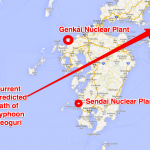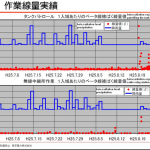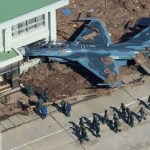japan
When the big tsunami hit Japan in 2011, many objects were washed out to sea. This flotsam provided for a giant "rafting event." A rafting event is when animals, plants, etc. float across an otherwise uncrossable body of water and end up alive on the other side. With this particular event, I don't think very many terrestrial life forms crossed the Pacific, but a lot of littoral -- shore dwelling and near shore -- animals and plants did.
Even though the Pacific ocean is one big puddle and you would think that any organism anywhere in it could just go to any other part of the ocean, like in the…
So here it is, already a week into 2015. Truth be told, I'm still finding myself having a hard time believing that it's already 2015, but then I say that about every year in early January. Be that as it may, I've already seen one hopeful sign that it could be a decent year when it comes to science refuting claims of the antivaccine movement. In fact, there's already been a study that once again fails to find even a hint of a whiff of a whisper of evidence for a link between vaccines and autism. It comes in the form of a study from Japan published online in Vaccine on January 3 (which, oddly…
Update:
The new forecast track of Neoguri is shown above as well as the location of two nuclear power plants.
The forecast track has moved south, and is now in a very good (and here good means bad) position to strike the Sendai nuclear power plant very directly. Keep in mind that this forecast may change.
On Tuesday mid day UTC the storm will likely be in the later phases of a turn to the right, aiming roughly at the Sendai plant. At this point maximum wind speed near the center of the storm will likely be about 90 mph, which puts the storm in the middle of the Category One range. That…
Fukushima Update #70: If you can't measure it, you can't analyze it.
by Analiese Miller and Greg Laden
It has been suggested, by various commenters on the internet, that the problem with Fukushima is not that there is a dangerous radioactive mess there, but rather, that the authorities in charge have decided that exposure to radiation is dangerous, when it really isn’t. The argument has been made that the evacuation of the region around Fukushima at the time of the meltdowns and explosions was unnecessary. This presumably also means that the exclusion zones, where people are not allowed to…
Reading a term paper by one of my Växjö students, I learned something surprising.
Being a well-read and erudite sort, Dear Reader, you may not be surprised. You already know that Japanese women have been having very few babies each since the 1950s, and that thus there's a growing shortage of strong young people to work in the care for the elderly. It has gone so far, and the prognosis is so dire, that the Japanese electronics industry is busy developing robots to care for old folks.
What I learned is that the problem is really one of xenophobia. All of Japan's neighbouring countries across…
By Larry Bock
Founder and organizer, USA Science & Engineering Festival
When searching for a prime, real-life example of how science and technology are making a difference in the world right now, my thoughts lately turn to a small but feisty greentech startup that you may never have heard of: Kurion, Inc.
Based in Irvine, CA with 15 employees, this profitable three-year-old company which specializes in nuclear waste cleanup has quietly and effectively been using its technology at the front lines of Fukushima, the site of what is being called one of the largest nuclear disasters in…
by Fred Bortz, author of Meltdown! The Nuclear Disaster in Japan and Our Energy Future (Twenty-First Century Books, 2012)
A year ago this week, on March 11, 2011, the biggest earthquake in Japan's history devastated the Tohoku region, 320 kilometers northeast of Tokyo. In the huge tsunami that followed, more than 13,000 people drowned, and thousands of buildings and homes were reduced to rubble.
Within hours, horrifying photos and videos spread around the world. But the most frightening news was yet to come. The Fukushima Dai'ichi nuclear power plant was seriously damaged and three of its…
by Mark Pendergrast
This is my third and final post about the state of Japan's renewable energy efforts and other measures that are vital to prevent further climate change and to wean the country from fossil fuel and nuclear power. In my first post, I covered the public-health impacts of climate change and explained why Japan is good indicator of whether countries will be able to act quickly enough in the face of these threats. Japan's reliance on imported fossil fuels gives it a good reason to invest in alternatives, and its technological sophistication should help it develop renewable-…
by Mark Pendergrast
This is my second post in a series of three about the state of Japan's renewable energy efforts, which are vital to prevent further climate change and to wean the country from fossil fuel and nuclear power. In the previous post, I covered the public-health impacts of climate change and explained why Japan is a good indicator of whether countries will be able to act quickly enough in the face of these threats. Japan's reliance on imported fossil fuels gives it a good reason to invest in alternatives, and its technological sophistication should help it develop renewable-…
by Mark Pendergrast
I'm going to talk about Japanese renewable energy in a minute, but first let me explain why.
In 2010, I published a book on public health (Inside the Outbreaks), and as a follow-up, I concluded that the overarching threat to the world's public health that we face in the coming decades is climate change, for a number of reasons. According to most scientists, three trends will conflate to create substantial problems. 1) We will run out of oil. 2) Climate change will have a profound impact on the environment and our lives. 3) The world's population will grow from 7…
It will probably be some years before we get the full story of what happened at the Fukushima Daiichi reactor complex after the earthquake.
Information has not exactly been put out coherently or comprehensively, but we can make some inferences from the data that is out there.
It is likely that one or two reactor vessels were breached with release of fuel and radioactive ash into the containment vessel.
There are a lot of nuclear agencies in Japan:
the JAEA - Japan Atomic Energy Agency - whose online environmental radiation monitors are now online (Oarai is the interesting one, between…
One day I was walking along a path dedicated to philosophers in Kyoto, Japan, with my friend Hitomi. It was interesting that there even was a path dedicated to philosophers. It made me think deeply about paths, which at the time was the subject of my PhD Thesis. Suddenly, earning a Doctorate of Philosophy with a specialization in Paths made sense. But that feeling wore off quickly enough when we something rather unusual unexpectedly appeared in the sky.
First, we heard it. A thump thump thump sound. Then we noticed other people looking up and in one direction, so we looked too. We…
In the early hours of March 11th, a 9.0-magnitude earthquake struck northern Japan, and a massive tsunami followed. More than 5,000 people are dead and almost 10,000 are missing. Hundreds of thousands are homeless, and those living near the Fukushima Daiichi Nuclear Power Station have been told to evacuate - while a small crew of brave workers remains nearby to try and avert catastrophic meltdown.
Here in the US, our budget debates highlight differing opinions about how much we want our government to do for us. The stories we tell ourselves make a virtue of self-sufficiency, and we highlight…
The workers remaining at Japan's Fukushima Daiichi Nuclear Power Station are braving extremely risky conditions as they try to avert a nuclear catastrophe. They are working to keep fuel rods - both those inside reactors and in the spent rods stored in ponds - cool enough to avert a Chernobyl-type meltdown, which would spew radioactive particles across the region. The most recent reports state that there are 50 workers remaining at the power station; all others have been evacuated as radiation levels have risen.
The New York Times' Keith Bradsher and Hiroko Tabuchi describe the workers'…
How about this for misleading tripe from the Grauniad:
Yup, according to them the reactor has killed 4277 people. Or at least, that is what it looks like. Of course, you could also argue that they are trying to claim that the reactors have made the Nikkei go up 5.68%, but no-one would believe that.
Incidentally, the NYT has some good disaster porn.
[Updates: for a non-panic-stricken view of Tokyo, JEB is worth reading. For some quiet discussion of nuclear power, Brian has the good taste to ref me, and to remind us of some discussions from 2005. Meanwhile, the Japanese appear to be reduced to…
As world watches Japan's nuclear plants, damage to manufacturing infrastructure poses chemical risks
By Elizabeth Grossman
After posting yesterday's story, I began to learn what a hub of chemical-intensive industry the region of Japan most directly affected by the earthquake an tsunami is. Hit with varying degrees of damage from the earthquake and tsunami are more than a dozen major petrochemical plants, most, according to a March 14 Goldman Sachs memo to investors, built in the 1970s. In addition, numerous factories that manufacture agrochemicals, silicon wafers, semiconductors, photovoltaic cells, and other high-tech items have all suffered damage as have warehouses and shipping container…
Nukes in Japan are going off like badly-racked champagne bottles, and the only thing fiercer than the radiation levels is the press circus (I liked that as a sort of simile-thingy, but actually at the moment the radiation levels aren't desperately fierce). How do you folks without blogs manage to bottle up your excitement without writing stuff? Perhaps you actually talk to people, how last-century. Anyway, taking advantage of a brief surge of SB uptime (still dunno what is going on, some people don't see any problem, but it was down for me all last night):
Some people are using the disaster…
by Elizabeth Grossman
Even before news of the crisis at the Fukushima and other Japanese nuclear power plants damaged by Friday's massive earthquake and tsunami arrived, raising public health concerns to an alarming level, the scenes of destruction prompted many questions about how public health - and that of first responders - would be protected during immediate rescue efforts, and later as clean up and restoration get underway. The awful loss of life demands much of our attention, but it's also essential to consider future health issues for those working on rescue and recovery.
Right now…
Click to enlarge images
ARTISTS employ a number of different techniques to represent implied motion in two-dimensional works. One of these, commonly used in posters, comics and animation, is the affine shear effect, whereby a moving object is depicted as leaning into the direction of movement. Cartoonists also use action lines to depict movement and speed, with straight lines conveying fast movements and wavy lines conveying slower ones. Motion can also be conveyed by superimposing several images showing the successive positions of a movement, or by a blurred image showing the different…
tags: Guide to Asian Emoticons, online life, cute, Japan, culture, silly, big boobs, streaming video
This is a rather silly guide to Asian emoticons .. except the emoticons I am seeing in this video are Japanese .. is Japan the emoticon capital of the Asian world? Hrm. Anyway, the straight boyz in the audience will especially like this video -- need I say more? =^.^=






